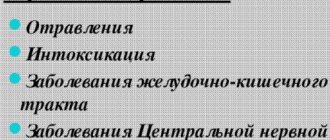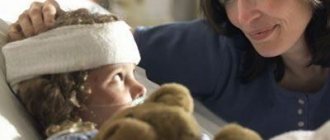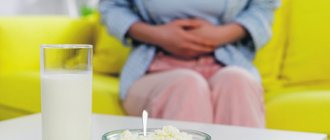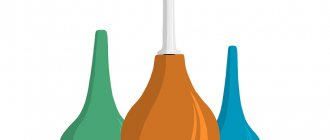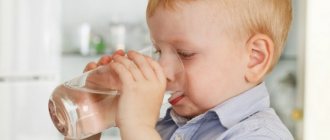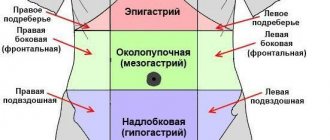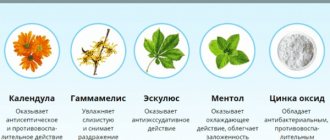Poisoning is a pathological condition that develops as a result of the interaction of a living organism and poison. A poison is any substance (complex of substances) that causes disruption of normal body functions. The most common cause of poisoning in early childhood is carelessness, which is associated with improper storage of medications and potent substances. In children, poisoning with drugs, household chemicals, poisonous plants and mushrooms, alcohol, and cauterizing substances is more often recorded. A feature of poisoning in childhood is the lack of reliable information about what and how much the child ate. Fearing the reaction of adults, children may hide information about the toxic substance; the taste parameters of the substance are not significant for the child.
Classification of poisonings
There are poisonings from drugs, household and industrial chemicals, poisonous plants and mushrooms. According to the method of poisoning, enteral, parenteral, percutaneous and inhalation poisoning are distinguished. For a social reason: as a result of an accident, intentional (suicidal, criminal) and unintentional (iatrogenic) poisoning. There are four periods of acute poisoning: latent, toxigenic (resorption), somatogenic (period of late complications), and recovery. Based on the severity of poisoning, they are divided into mild (without impairment of vital functions), moderate (with impairment of vital functions) and severe (with the development of life-threatening conditions).
Diagnosis of acute poisoning
During initial contact with the child and his relatives, it is necessary to establish:
- the nature of the toxic substance and its quantity;
- the way the poison enters the body;
- the time elapsed from the moment of receipt of the toxic substance until the start of the medical examination;
- time from the moment of receipt of the toxic substance until the first signs of poisoning appear;
- the nature and rate of change in clinical signs of poisoning;
- assistance provided before the doctor arrived;
- in case of enteral poisoning, the time of the last meal and its nature.
If there are remnants of the drug taken or its packaging has been preserved, then you must take them with you for subsequent transfer to the hospital doctor. This will allow us to guess the duration of the latent period and the maximum effect of the poison.
If the nature of the poison is unknown, they try to suspect it by a combination of individual symptoms typical of a particular substance (see Appendix No. VII).
What parents should do if their child has food poisoning
Providing medical care for poisoning
If a child has food poisoning, the most important thing is to promptly provide the child with medical care. If you are on vacation, contact the administration of the hotel or recreation center so that they can take immediate action. If you are at home, then, depending on the situation, call a doctor, emergency or ambulance. In the event of a sharp deterioration in the condition, immediately call an ambulance (even if you have previously called a doctor to your home); dangerous syndromes include: vomiting or diarrhea with blood, delirium, hallucinations, loss of consciousness, asphyxia (the child is suffocating), weakened pulse, cyanosis skin (the child begins to turn blue).
Always remain calm, do not frighten, but rather calm the child. Describe clearly and in detail to a medical professional over the phone the essence of the problem and symptoms, ask for general recommendations over the phone on what you need to do before the ambulance or doctor arrives.
Please note that the symptoms of the disease may only look like poisoning, but in fact it may be a completely different disease, for example, sunstroke. Only a doctor can make a qualified diagnosis.
Clinical manifestations of poisoning
The central nervous system is characterized by changes in behavior, depression of consciousness, hallucinations, delirium, convulsions, and changes in reflexes. Changes in skin color and moisture, nausea, vomiting, disturbances in gastrointestinal motility, changes in breathing rhythm, arterial hypo- or hypertension, acute vascular insufficiency, and acute heart failure may be recorded. If the liver or kidneys are damaged, liver or kidney failure develops, respectively.
First of all, it is necessary to identify conditions that threaten the patient’s life (impaired consciousness - delirium, coma; respiratory disorders, convulsions, arrhythmia, shock, collapse, persistent hyper- or hypothermia). In these conditions, emergency measures to maintain vital functions and pre-transport preparation are often necessary, since even very short-term transportation can significantly worsen the patient’s condition.
Severity of acute poisoning in children
| Severity | Poisons that depress the central nervous system | Poisons that excite the central nervous system |
| I | Drowsiness, severe lethargy, but the child answers questions. | Anxiety, increased excitability, sweating, tremor, hyperreflexia, facial hyperemia. |
| II | Loss of consciousness with preservation of pain sensitivity and most reflexes. | Psychomotor agitation, tachycardia, extrasystole, tachypnea, moderate fever. |
| III | Loss of consciousness, pain sensitivity and reflexes, but without respiratory or circulatory depression. | Delirium, doubtfulness, arterial hypertension, tachycardia, arrhythmia, convulsions, hyperthermia. |
| IV | Coma, respiratory failure, III vascular collapse, areflexia. | Same. |
Principles of emergency care:
- Removal of the victim from the source of the lesion (in case of inhalation poisoning with volatile substances).
- Primary measures: removal of unabsorbed poison from the skin, mucous membranes, and from the gastrointestinal tract.
- Removal of absorbed poison.
- Symptomatic therapy.
- Antidote therapy (carried out only when the nature of the toxic substance and the corresponding clinical picture have been established).
Measures to take if poison gets on the skin or mucous membranes of the eyes:
- Completely undress the child and thoroughly rinse all areas of contact with the toxic substance with copious amounts of cool water. Use soap when removing oily substances.
- If poison gets on the conjunctiva (cornea), it is advisable to use an isotonic solution (or clean running water) for 10-15 minutes to wash off the poison; you can drip a 5% solution of novocaine or dicaine into the eyes.
Measures for enteral poisoning:
- Before the ambulance arrives, give activated charcoal inside. The dose of activated carbon for children under one year of age is 1 g/kg body weight; for children 3-16 years old 25-50 g, for adults - 50-100 g. Thus, the daily dose is 0.1-0.5 g/kg body weight. The required dose of sorbent is mixed in 8-10 times the amount of water. If there is no activated carbon, in the absence of contraindications, induce vomiting by pressing on the root of the tongue.
Contraindications for artificial vomiting:
- age up to 9 months;
- poisoning with alkalis, acids, gasoline; kerosene, turpentine, phenol (it should be remembered that most pesticides are found in gasoline-based solvents);
- confusion, weak gag reflex;
- poisons that quickly damage the central nervous system (cyanides, tricyclic antidepressants);
- cardiotoxic chrononegative poisons,
- arterial hypertension;
- unstable hemodynamics;
- bleeding from the gastrointestinal tract;
- convulsive syndrome.
Spontaneous or induced vomiting does not exclude the need for subsequent gastric lavage.
- Tube gastric lavage is carried out within 24 hours from the moment of poisoning. It is preferable to carry out this procedure in a medical institution:
- The patient’s position is sitting, in case of impaired consciousness – lying down, head turned to one side;
- the depth of insertion of the probe is determined by the distance from the incisors to the xiphoid process or by the gas outlet from the probe;
- water at room temperature is used as a washing liquid; for children under one year of age, an isotonic sodium chloride solution is used;
- calculation of the amount of liquid: 1 l/year to clean water, but not more than 10 l, for children under one year old - 100 ml/kg body weight, not more than 1 l (volume of liquid for gastric lavage - see Appendix No. 5);
- in case of development of deep coma (inhibition of the cough reflex) and other life-threatening conditions, tracheal intubation is performed before tube gastric lavage;
- after gastric lavage, an enterosorbent is administered through a tube: hydrolytic ligin, polyphepan at a dose of 1 teaspoon per year of life, activated carbon 2 tbsp. spoons in a glass of water and leave it in the stomach for 10 minutes, followed by complete elimination;
- if poisoning with cholinomimetic drugs is suspected, as well as bradycardia, a 0.1% atropine solution of 0.1 ml is administered before gastric lavage for 1 year of life, for children under 1 year of age - 0.1 ml.
Contraindications for gastric lavage:
- Poisoning with poisons that damage or cauterize the mucous membrane (gastric lavage is possible only in the first minutes after taking the poison, due to the danger of perforation by the probe of the altered wall of these organs). In case of poisoning with poisons that reduce smooth muscle tone (barbiturates), gastric lavage should be done in the first 2-3 hours after taking the poison, since at a later date it is better to only suction the gastric contents.
- Severe hemorrhagic syndrome or gastrointestinal bleeding.
- Cerebrovascular accident.
Gastric lavage should be temporarily postponed in children with convulsive syndrome, with decompensation of blood circulation and breathing until the child’s condition has stabilized.
Possible complications: aspiration, tension pneumothorax, esophageal perforation, epistaxis, electrolyte disturbances, cardiac arrhythmias.
Contraindications
You can rinse the stomach at home only if the child is fully conscious and able to follow your recommendations. The procedure is not performed if:
- Loss of consciousness
- Acute gastric bleeding or suspicion of it - the presence of blood clots, streaks of blood in the vomit, feces.
- Convulsions, epilepsy.
- Burns of the oral cavity, larynx, esophagus with acids or alkalis.
- Narrowing of the esophagus or gastric inlet atresia.
- Severe neurological disorders and diseases of the cardiovascular system.
Gastric lavage technique in children - algorithm
Another way to cleanse your child's stomach of toxins is to give an enema. This procedure is carried out when the baby is not able to drink large amounts of water. In this case, other actions are necessary:
- Lay cellophane on a horizontal surface, place the baby on it with his left side, and pull his legs to his chest.
- The procedure can be carried out by drawing the solution into a regular pear-shaped enema or Esmarch mug.
- Lubricate the tip of the device with Vaseline (glycerin, oil) and carefully insert it into the anus.
- By pressing the enema, liquid is injected. If you are using an Esmarch mug, you need to open the tap and wait for the device to empty.
- Explain to your child how important it is to keep fluid in the intestines for several minutes.
We recommend: Stages of cleansing the body after quitting smoking
The amount of fluid administered depends on the patient’s age.
For infants this is six hundred milligrams. For each year of age, half a liter of liquid should be added. So for a three-year-old child, the recommended volume is one and a half liters.
If the child begins to complain of pain, the procedure should be stopped.
VIDEO: GASTRIC WASHING FOR A CHILD
Solution temperature
Whatever method is chosen to cleanse the stomach of toxic substances, the solution introduced into the body must be warm - approximately plus 27-29 ° C.
Cold liquid causes spasm of the esophagus, which makes it difficult for vomit to escape.
Elevated temperature promotes the dilation of blood vessels, thereby speeding up the process of absorption of toxic substances by the body.
Age allowed for procedures
You can cleanse your child’s body from the first days of his life. Unfortunately, the baby can be poisoned in the first hours after birth. The only limitation when carrying out a cleansing procedure is that at such a tender age, medical workers must carry out manipulations and only using special tools!
Starting from four months, parents can also rinse the child’s stomach with an enema, but doctors must install probes.
Starting from the age of one, it is allowed to induce vomiting in an infant.
Composition and volume of solution
The choice of solution and volume of liquid depends on the cause of poisoning and the age of the patient.
Based on many years of practice, the following options for cleansing preparations are recommended in medicine:
- A solution of potassium permanganate (potassium permanganate) is pale pink. Be sure to strain the liquid through gauze folded in several layers. This is necessary to prevent manganese crystals from entering the patient’s stomach - serious intestinal burns are possible.
- Two to three tablespoons of salt are diluted in five liters of boiled water. The saline solution prevents toxic substances from being absorbed into the body. This cleansing is recommended in severe cases of poisoning in children under three years of age.
- One teaspoon of freshly squeezed lemon juice is diluted in a liter of water. This composition weakens the effect of the poison and cleanses the stomach.
- The use of sorbent powders (drugs that absorb toxins). The most popular products are Activated Carbon and Polysorb.
We recommend: Products that delay fluid excretion
As for the volume of fluid introduced into the body, the following proportions must be adhered to:
- two hundred milliliters for newborns;
- for babies aged from one and a half to six months - three hundred to five hundred milliliters;
- One-year-old children are administered from five hundred to seven hundred milliliters.
Starting from the age of one, a liter of liquid is added for each year of life.
Efficiency of the procedure
Timely and proper cleansing will help avoid serious problems in the functioning of the kidneys and liver.
Toxic substances are absorbed into a child’s body much faster than in an adult. The cleansing procedure must begin no later than two hours after signs of poisoning are detected.
Washing should also be carried out in cases of chemical poisoning or drug overdose.
